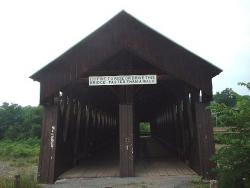The total length of the Columbia-Wrightsville Bridge is 7,374 feet. Its construction required 100,000 cubic yards of concrete and 8 million pounds of steel reinforcing rods.
Bridges


The Choate Bridge of Essex County, completed in 1764, is the oldest documented two-span masonry arch bridge in the United States. Named after Colonel John Choate, who supervised the construction, the bridge is located on South Main Street and spans the Ipswich River. Originally, the bridge measured 80 feet 6 inches long and 20 feet 6 inches wide. In 1838 it was widened to 35 feet 6 inches on the east side in order to accommodate another lane of traffic. The west side and the parapet of the bridge, along with the inscription to Colonel Choate, remained unchanged.

The Carrollton Viaduct over Gwynn's Falls was the first masonry railroad viaduct constructed in the United States. This structure proved the feasibility of using a viaduct to transport railway vehicles across wide and deep valleys.

In 1894, Catawba County, North Carolina commissioners asked local landowners to build and maintain an 85-foot-long bridge across Lyles Creek. The community hired Andy L. Ramsour, who served as keeper of the Horseford covered bridge over the Catawba River in Hickory, North Carolina.

For more than 174 years, the Canton Viaduct has stood as a dominating structure on the New England landscape. When completed in 1835, the slightly curved, granite masonry bridge - 615 feet long, 70 feet high, and 22 feet wide - carried a single track of the Boston and Providence Railroad, providing a critical link in the establishment of rail service between Boston and New York. In 1860, a second track was added. With few major alterations, the viaduct has continued to provide safe rail transportation to heavier and faster loads throughout the 20th century.

Cabin John Aqueduct, designed by Montgomery C. Meigs, conveys drinking water from Great Falls, Maryland to Washington, D.C. It was the longest stone masonry arch in the world for nearly 40 years. The segmental arch of the bridge has a span of 220 feet and a rise of only 57 feet. The main arch ring is built of cut and dressed granite. The secondary arch ring is radially-laid sandstone, of which the rest of the bridge is also constructed.

On May 24, 1883, with schools and businesses closed for the occasion, New York celebrated the opening of the Brooklyn Bridge. Also known as the Great East River Bridge, it was built over 14 years in the face of enormous difficulties. Deaths, fire in the Brooklyn caisson, and a scandal over inferior materials all added to the turmoil. The bridge is one of the most well-recognized symbols of American engineering, and remains the unofficial Eighth Wonder of the World.

A product of the Northern California Gold Rush, the Bridgeport Covered Bridge is believed to be the longest, single-span, wooden covered bridge in the United States. Crossing the south fork of the Yuba River at a span of 233 feet, the bridge was built by the Virginia City Turnpike Company as part of a 14-mile toll road authorized by the California state legislature. The toll road was an essential link connecting Virginia City, Nevada, and the silver-producing Comstock Lode with the centers of California commerce.

Nicholas Montgomery Powers built the bridge. It was first constructed behind the village, then taken apart and reassembled over the stream. Some residents questioned the idea of re-constructing it, but Powers was so confident of the bridge's durability that he sat on the roof when the final trestles supporting it were removed. From his perch he reportedly said: "If the bridge goes down, I never want to see the sun rise again!"

Soon after gold was discovered at Sutter's Mill near Sacramento in 1848, General John Bidwell found gold near the Middle Fork of the Feather River. His discovery brought hordes of miners to the scene and Bidwell Bar was born. The Bidwell Bar Suspension Bridge over the Feather River was one of several suspension bridges built in the region in the 1850s, and is the only one that remains.


